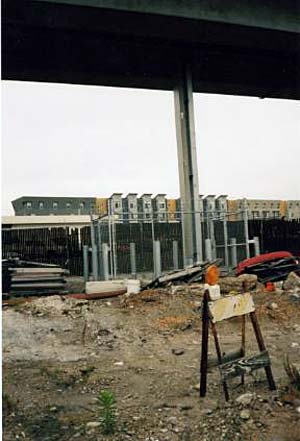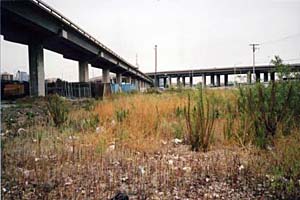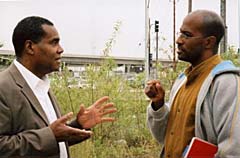Oakland's Odyssey
Air Date: Week of June 3, 2005

Van Jones, Executive Director of the Ella Baker Center for Human Rights, and Steve Curwood at the former site of the Red Star Yeast Factory in West Oakland. The reclaimed site will be developed into a community training center. (Photo: Eileen Bolinsky)
Oakland, California is a major port for the country's commerce, and the people who live in the area bear the brunt of the resulting pollution, from idling diesel trucks to smokestack factories. Community leader Van Jones is working to clean up the city, and at the same, give its poorer neighborhoods jobs. He takes host Steve Curwood on a tour of an abandoned lot in West Oakland, which he sees as a success story.
Transcript
CURWOOD: It’s no coincidence that the landscape of Oakland, California resembles something out of a Star Wars movie. George Lucas modeled his storm trooper carriers after the huge white cranes that sit along the city's port, methodically raising cargo from incoming tankers to waiting railcars. These cranes are a symbol of just how much industry is a part of the city…and for that matter, how much commerce is part of the nation. But people like Van Jones believe part of Oakland's community pays more than its fair share of the price. On any given day, Van Jones says, factories and trucks spew fumes into the air that have created some of the highest asthma rates in the country, as well as other illnesses. A lawyer by training, Mr. Jones is executive director of the Ella Baker Center for Human Rights, and he says by cleaning up the city, he can help people breathe easier, live safer, and get better jobs. I met up with Van Jones at an abandoned city lot on a busy city intersection in industrial West Oakland.
|
JONES: West Oakland is a community where 80 percent of the folks who live here live within an eighth of a mile of an industrial site, um, literally a stone’s throw, so it’s very, uh, unhealthy. It’s an asthma epidemic. You know, you go to the public schools, you know you see little second and third graders, more than half of them have an inhaler in their pocket. Um, I mean, it’s really an epidemic here and so the struggle in west Oakland, not just for jobs and economic development, but for economic development that won’t make things worse… CURWOOD: Uh-huh. JONES: That’s the whole game. That’s what it’s all about. CURWOOD: Who lives here? JONES: Um, black folks live in west Oakland. (LAUGHS) You know, west Oakland is, uh, traditionally African American, low income, working class community. Um, more and more different kinds of people, you know, live here, but you know west Oakland is still considered an African American community. And it used to be a brilliant, beautiful, thriving, amazing place and then over time like so many urban communities it fell on hard times and it fell prey to, you know, polluters, toxifiers, and one of the worst, um, was the Red Star Yeast Factory. CURWOOD: Uh-huh. JONES: If you see this big empty lot here… CURWOOD: Yeah. JONES: This used to be, uh, one of the nastiest smelling industrial sites anywhere in northern California. I mean because they’re making yeast the kinds of smells that would be coming out all hours of day, the noise, um, was just horrendous. For a while, people just accepted it, but then a local community organization did some research and found out that it wasn’t just that it was bad smells, but that it was carcinogenic and that explained a lot of the health issues around here. And so there was a community mobilization to shut this place down and you can see we won. CURWOOD: At this Red Star Yeast plant, what came out that was so toxic? JONES: Well, carbon monoxide was coming out. Sulfur dioxide was coming out. Something called acetaldehyde. I mean there were chemicals coming out the community people couldn’t even pronounce. And the only thing that we knew was that our children were being hospitalized for asthma at seven times the rate of any place else in California. And so, we knew something had to be done. CURWOOD: So, um, what happened here to shut down this plant? One day it’s here, the next day it’s gone. It took some kind of work. What was it? JONES: Well, you know, we’re lucky because in west Oakland and really all across America we have environmental heroes and sheroes who were willing to stand up. The Pacific Institute who, you know, have PhDs and scientists and stuff on staff, you know they did an environmental indicators project and discovered all these poisons that were coming out into the community. And then we had heroes like, um, you know, Margaret Gordon who’s an African American grandmother, who you know, won’t take it, you know. And she and others like Mia Mazinatoto stood up and stood up to the powers that be. CURWOOD: What did they do? Did they march, did they picket, did they protest, did they sit-in, did they write letters? What did they do? JONES: Yes. (laughs) They did it all. They did everything from, you know, writing letters, having sit-down meetings. But mainly what they did was they did some civil disobedience. They said, listen you can’t bring those trucks in and out of here any more. And they went to the air quality management district that had been asleep at the wheel for decades letting this poison go and they brought the facts and the figures and they got this thing shut down. And by them shutting this one factory down, they opened up the possibility for west Oakland to become a community that everybody can be proud of. CURWOOD: These days environmental activism and civil disobedience, those two phrases don’t go together that often. Why do you suppose that is?  Residential buildings are just a stone's throw from what used to be the Red Star Yeast factory. (Photo: Eileen Bolinsky) |
JONES: You know, I just think that we’ve forgotten our history. I think that the people want the civil rights movement to either just be Dr. King giving a speech or they just want it to be the Black Panthers you know, raising a fist. And the reality is that you have people of all colors coming together across the country that have different visions for America, wanted America to lead the world in human rights and were ashamed of the failures of this country to live up to its best promises and they changed the country, absolutely changed the country. Similarly now across the country you have people who are very concerned about America leading the world in pollution, in consumption, in waste. Driving the global warming crisis to a peak point and those people are not just white affluent people who live the suburbs. People of color read the newspaper too. And we want to see a change happen that will not only benefit the global, uh, situation, but also can make our community stronger and that’s what this new urban environmentalism allows for. [WALKING THROUGH EMPTY LOT] JONES: I got to tell you it feels good to be walking on, uh, what used to be, you know, this place was killing people. CURWOOD: So now, has the asthma rate improved here? JONES: Um, the asthma rate, has improved marginally. The other problem that we have is that we got the biggest stationary source removed, but then look over here. When you’re standing in west Oakland the port is right over there. Products come here from all around the world. Big diesel trucks come and idle in our community to take those products to the suburbs, to the affluent areas, but we bear the burden in our lungs of those trucks sitting there to take something out to the malls all over the country. Um, why can’t those trucks use biodiesel? Why can’t those trucks use clean energy so that as this commerce is happening and benefiting people over, abroad and throughout America, we’re not suffering. That’s jobs. Skilled jobs, what we call green collar jobs. CURWOOD: Green collar jobs. JONES: That’s what we want. Blue collar jobs are the jobs of the past with the manufacturing that’s leaving. White collar jobs are jobs that people aspire to but often it’s narrow at the top. But, you look around you, there’s no amount of, you could have a hundred people here right now working, uh, to improve the way this place looks and feels, they’d be working here ten years from now because there’s so much because there’s so much urban renewal at work. There’s so much urban restoration that is required now. As more people come into the city, they’re coming to urban areas. CURWOOD: OK, here we are, the San Francisco Bay has 200 plus mayors from around the world here gathering for World Environment Day. They come from anywhere from Kabul in Afghanistan to Shanghai in China to Curitiba in Brazil, London, England. What’s the message from Oakland, California from you Van Jones to these mayors? JONES: Well, uh, the message is that environmentalism is not an elite issue. It’s not an issue that’s just for the affluent people to be concerned about. That the environmental, uh, burden of community health and sickness and death falls on the slums. It falls on the poor. What we want to say is that every single mayor who’s here has a slum in their community. They have a low-income area. They have a ghetto. They have a barrio. In every slum put a green job training center so that people can come in and learn how to do rain water reclamation, permaculture, uh, how to put solar cells up. Help people who have economic needs and community health needs meet those needs through a new environmentalism. That’s about social uplift as well as saving the planet. That’s what we’re saying. You know, one of the reasons that we do what we do in holding out a different vision is Dr. King didn’t get famous with a speech called, “I have a complaint.” CURWOOD: (laughs) JONES: He had a dream. We have a dream in west Oakland. CURWOOD: So, uh, if you were going to give this speech today, and it’s 2005 and not 1963 what would you say? I have a dream, dot dot dot.
|







